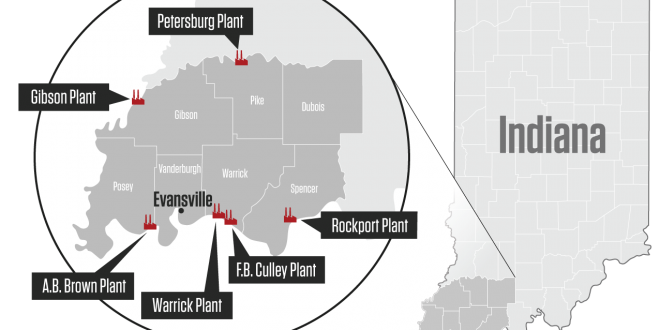Podcast: Play in new window | Download (Duration: 3:05 — 3.3MB)
The Indianapolis Power and Light Company (IPL) announced on December 9th that they would be shutting down two of their biggest units at the Petersburg Super Polluter coal plant. Their plan is to have both units completely retired by 2023. WFHB Correspondent Katrine Bruner reports the company will still have the remaining two plants in Petersburg until at least 2042.
Coal is a combustible black or brownish sedimentary rock with high amounts of carbon and hydrocarbons, also classified as the world’s dirtiest energy source, and America has plenty of it.
According to the article posted by the National Academies of Science Engineering and Medicine, U.S. coal mines produced about 900 million tons of coal in 2015, with nearly all of it destined for domestic electricity generation.
More than one-fourth of the world’s total known coal reserves are located in the United States.
One of the leading causes of climate change was the first Industrial Revolution which began in the late 19th century. A large contributor to this period in American history was the mass burning of coal for energy.
According to Greenpeace, coal is the single largest contributor to global warming with one-third of all global carbon dioxide emissions coming directly from burning coal.
Power plants that burn coal have been contributing to the air and water pollution which leads to many negative health effects for humans.
Greenpeace stated on their webpage that 36,000 Americans die every year as a result of air pollution from these coal-fired power plants.
***
Since the Industrial Revolution began in the Northeast area of the United States, the midwest has been heavily affected by these conditions for decades. Indiana included.
However, according to a 2018 report published by the Indiana Department of Environmental Management, the state has made “significant progress” in reducing its levels of ozone and air pollutant PM (particle matter) 2.5. In other words, there is still hope for Indiana.
***
Bloomington Indiana is categorized as “moderate” in terms of air quality, however there are still other factors to consider when looking at this data.
As a college town, Bloomington is constantly growing with more people, more buildings, and as a result, more energy consumption. With this in mind, IU began to make environmental changes on campus. In the year 2000, they were given three Gold certifications from the U.S. Green Building Council for developing 19 Green Buildings and following the path for Leadership in Energy and Environmental Design for the campus.
The Green buildings included many factors contributing to a more sustainable design, including a stormwater-detention system, designed to reduce stormwater runoff from the site by 92-percent and a curtain wall on the south side of the building maximizing daylight potential. One of their buildings, University Hall is made of 43 percent recycled material.
As such a vast dumping ground for pollution that the midwest is, it is clear that there must be more changes made for the sake of citizens living in the 21st Century, who are consuming way more energy than ever anticipated by Americans when the Industrial Revolution began.
 WFHB Bloomington Community Radio
WFHB Bloomington Community Radio


